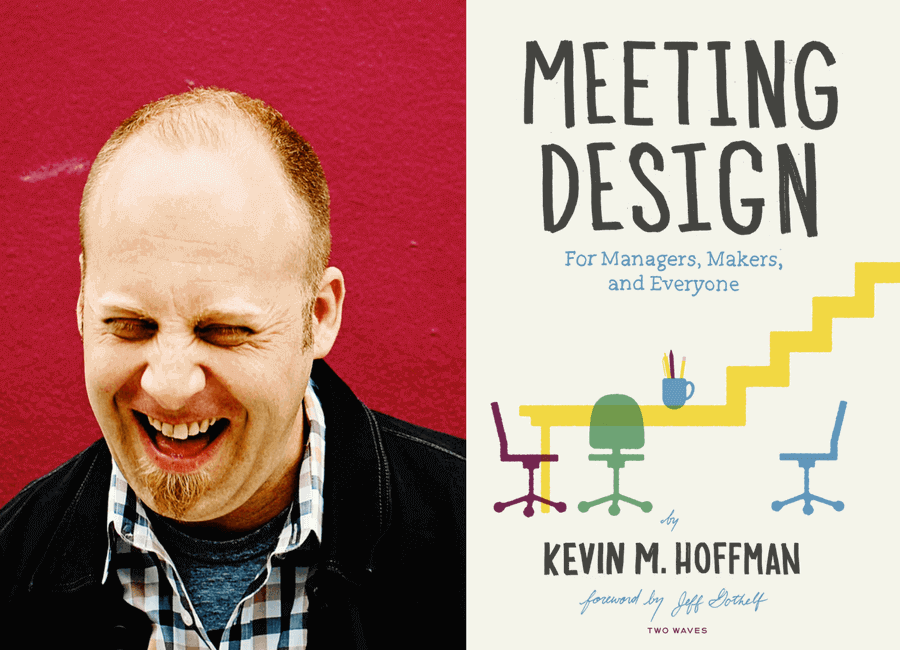But they often end up being inefficient, create more work (not less) and don’t solve the problems that they’re supposed to.
After one particularly aimless discussion, information architect and design strategist Kevin M. Hoffman decided that meetings themselves could be reframed as a design problem. His premise – that a meeting is something that can be designed to be useful and compelling – opens up a whole new world of possibilities.
Kevin’s new book, Meeting Design, applies many design approaches (including user experience design techniques) to the concept of meetings. He shares some insights from the book with us in a Q&A interview.
How did your own experience of being in meetings over the years (particularly in the design world) form the idea of the book?
The more time I’ve spent in my career, the more I’ve found meetings being a central theme across many work contexts. But, I’ve been really fortunate in that I’ve been exposed to really smart people doing really smart things over the years. I’ve tried to remember to ask them, “Hey, why do you do things that way?” And then when I’ve applied models in new contexts, I’ve learned that it matters more to be able to learn from (meeting) failures than seeking out the “perfect” approach to agenda building or facilitation.
In what ways are meetings problematic e.g. they aren’t doing the work they should be doing?
There are three ways that I can think of meetings being problematic. There are meetings that you expect to be a challenge, such as difficult conversations with expected conflict. There are also meetings that you don’t expect to go badly, where surprises from people, technology, or the culture of the organisation derail the mood or the intended outcomes.
And finally, there are meetings where there are no surprises or expected conflict, but they just seem … “less than ideal,” or unfulfilling. I hope the methodologies collected in the book provide a route to address all three kinds; and manage conflict while dealing with the unexpected, and increase clarity about meeting outcomes.
As with any design problem, it’s vital to first understand what the design constraints are. What are the design constraints for meetings?
The physical environment, the organisational culture, people’s ability to align on ideas, and time all place constraints on meetings. They interact with one another. For example, a culture that prizes consensus will probably have meetings that go over time, and, as a result, people will be late for the next one.
Businesses usually focus on the total cost of meetings as the hourly wage of everyone who attends multiplied by how long the meeting lasts. But there is an important human cost too?
The human cost includes things like loss of momentum and energy; the exhaustion that comes from quickly switching contexts. On a normal day, I have between three and six meetings, and very rarely are those meetings all about the same thing. The time and energy it takes someone to refocus their cognitive lens is fundamentally a human cost.
You use a UX analogy in the book when you say that ‘Meetings are usability tests for organisations themselves’. What do you mean by this?
Meetings have the capacity to provide insights into the culture of an organisation; what it takes to build clarity or progress in that culture. An organisation that has very effective meetings could have established rituals and a high degree of clarity around what value those rituals are providing (and how to measure that value).
For someone joining that organisation, the easier those meetings are to understand, the more “useful” the organisation becomes to them. For a manager, those rituals and measurements are gateways to understanding how to get the most from the meetings you have with your team.
One of the biggest take-homes from the book is the importance of a facilitator in a meeting? How does the role help design better meetings?
If you are explicit about who is facilitating a meeting, it removes ambiguity about who has put in the forethought on why everyone is in the room together. They become a guide. If that person is seen as a neutral party, the attendees will trust them to guide them through ambiguity and conflict.
Designing a meeting means more than just writing an agenda. What are some of the first steps in designing a meeting?
Ask yourself these questions. First, what outcomes are you seeking, not from the meeting itself, but from the larger process which the meeting is intended to serve?
Second, what decisions are required for those outcomes, and which of those decisions can be made in a meeting? And finally, what agenda is going to best align those decisions to those outcomes, and who would be best positioned to facilitate that agenda?
Most meetings are conducted through people talking and listening. You make the point that this isn’t the way our brains work to their best advantage (the brain finds more meaning by combining listening with seeing or with touch). Can you explain a little more on these ideas of visual facilitation and multimedia learning?
I believe we carry a bias that our brains all work roughly the same way, but it very much isn’t true. Some people think in pictures. Visualisation provides rich inroads to additional levels of understanding that are not possible without pictures, and for some, that’s the only way to “getting it.”
By combining visual and aural content, in a complementary fashion, you create a more universally accessible meeting experience. Think of it as “universal design” for meetings.
You outline many different types of meetings in the book, including the ‘Quickoff’. Can you explain more about this meeting type and why it’s so important to get it right?
A ‘Quickoff’ is a fun name for a fast kickoff meeting. Kickoff meetings are probably one of the most important meetings in a process; they define what everyone working on something believes is real about the work, and what they believe can be possible.
Alignment at the beginning can save time and money in the long run, but if you don’t have time for a more robust kickoff meeting, a ‘Quickoff’ is the bare minimum I would suggest for getting everyone on the same page.
Some of the best ideas come from tangents in meetings – but tangents can also bring the meeting completely off topic. What’s the best design approach for tangents in meetings?
Have a facilitator with sufficient domain expertise to identify valuable tangents, tease the value out of them, then decide which tangents are worth pursuing further.
Meeting Design: For Managers, Makers, and Everyone is published by Rosenfeld Media – visit the website for more information.





